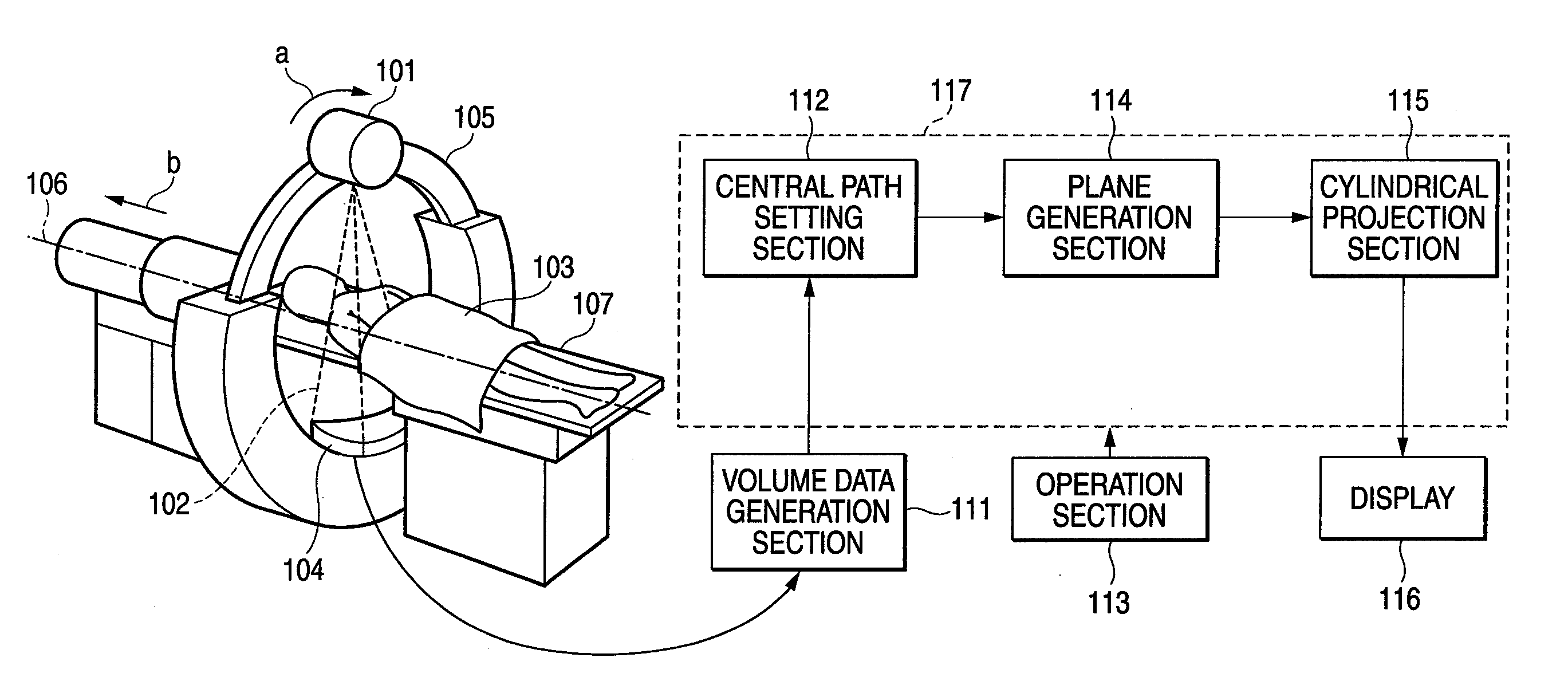Image processing method and computer readable medium for image processing
a technology of image processing which is applied in the field of image processing method and computer readable medium for image processing, can solve the problems of weakening the image quality of the image obtained by the parallel projection method, affecting the accuracy of the position or size of the polyp or the like in the wall of the tubular tissue, and affecting the quality of the imag
- Summary
- Abstract
- Description
- Claims
- Application Information
AI Technical Summary
Benefits of technology
Problems solved by technology
Method used
Image
Examples
example 1
[0073]FIGS. 3A and 3B are drawings to describe example 1 of the image processing method of the invention. In the example, the direction of the gradient vector in the voxels forming the surface of the polyp 12 is used to acquire an angle θ1 (arrow A) between the tissue surface of the polyp 12 and the virtual ray 11 as shown in FIG. 3A.
[0074]As shown in FIG. 3B, for example, using a conversion function f such as a look-up table (LUT) or a piecewise continuous function, the angle θ1 is converted into an angle θ2 (arrow B: θ2=f (θ1), θ2>θ1), the angle θ2 is made larger than the angle θ1 in a simulated manner, and the polyp 12 is rendered as if it were a polyp 14 with large swelling for enhancing the shading of the polyp.
[0075]FIG. 4 shows an LUT function example in this example. As shown in the figure, if the angle θ1 at the edge portion is small, the LUT function is used to convert the angle from θ1 into θ2 so that the angle becomes larger in a simulated manner for rendering the polyp....
example 2
[0077]FIGS. 5A and 5B are drawings to describe example 2 of the image processing method of the invention. In the example, the direction of the gradient vector in the voxels forming the surface of the polyp 12 is used to acquire a shading coefficient β1 for representing the shading. Specifically, the shading coefficient β1 is calculated with respect to a gradient vector G of the surface of the polyp 12 and a direction S of the virtual ray 11 (arrow C: β1=|G·S| [· is inner product]) as shown in FIG. 5A.
[0078]As shown in FIG. 5B, for example, using a conversion function fusing a look-up table (LUT), the shading coefficient β1 is converted into β2 (arrow D: β2=f (β1), β21). Then, by using the shading coefficient β2 that is lessened in a simulated manner, the polyp 12 is rendered with shading as if it were a polyp 14 with large swelling, for enhancing the edge of the polyp.
[0079]FIG. 6 shows an LUT function example in this example. As shown in the figure, if the shading coefficient p at ...
PUM
 Login to View More
Login to View More Abstract
Description
Claims
Application Information
 Login to View More
Login to View More - R&D
- Intellectual Property
- Life Sciences
- Materials
- Tech Scout
- Unparalleled Data Quality
- Higher Quality Content
- 60% Fewer Hallucinations
Browse by: Latest US Patents, China's latest patents, Technical Efficacy Thesaurus, Application Domain, Technology Topic, Popular Technical Reports.
© 2025 PatSnap. All rights reserved.Legal|Privacy policy|Modern Slavery Act Transparency Statement|Sitemap|About US| Contact US: help@patsnap.com



